- News
- Reviews
- Bikes
- Accessories
- Accessories - misc
- Computer mounts
- Bags
- Bar ends
- Bike bags & cases
- Bottle cages
- Bottles
- Cameras
- Car racks
- Child seats
- Computers
- Glasses
- GPS units
- Helmets
- Lights - front
- Lights - rear
- Lights - sets
- Locks
- Mirrors
- Mudguards
- Racks
- Pumps & CO2 inflators
- Puncture kits
- Reflectives
- Smart watches
- Stands and racks
- Trailers
- Clothing
- Components
- Bar tape & grips
- Bottom brackets
- Brake & gear cables
- Brake & STI levers
- Brake pads & spares
- Brakes
- Cassettes & freewheels
- Chains
- Chainsets & chainrings
- Derailleurs - front
- Derailleurs - rear
- Forks
- Gear levers & shifters
- Groupsets
- Handlebars & extensions
- Headsets
- Hubs
- Inner tubes
- Pedals
- Quick releases & skewers
- Saddles
- Seatposts
- Stems
- Wheels
- Tyres
- Health, fitness and nutrition
- Tools and workshop
- Miscellaneous
- Cross country mountain bikes
- Tubeless valves
- Buyers Guides
- Features
- Forum
- Recommends
- Podcast
TECH NEWS
Just In: Factor Vis Vires
We told you last week that the Factor Bikes Vis Vires is now available through the company’s new online shop and now – strike a light! – we’ve only gone and got one in for review at road.cc. We grabbed the bike’s designer, Steve Domahidy, to tell us all about it.
At first sight the Vis Vires might look vaguely similar to a lot of other bikes out there, but take a closer look and you’ll see that it has a split down tube and fork blades that extend right up to an integrated stem. Take an even closer look and you’ll notice the extraordinary level of integration here. The brakes are hidden away behind the fork legs and behind the bottom bracket, the cabling is internal – fully internal – and there’s a speed sensor incorporated in a chainstay.
There’s even a Garmin 810 GPS computer included as part of the package. It sits on a mount integrated into the stem, and the bike is fitted with Factor’s own power-measuring Power Cranks. The complete 56cm bike with everything attached hit the Road.cc Scales of Truth at 7.39kg (16.3lb).

Naturally enough, none of this comes cheap. For this complete bike, including the computer, the power cranks and a Sci Con travel bag, you’re looking at £9,999. Ditch the cranks and it’s £7,999. Mass market, it ain’t.
Factor is owned by bf1systems, a Norfolk-based company that makes electrical, electronic and composite parts for the motorsport, automotive, aerospace and marine industries. They say that every Formula One team uses their products to some degree or other.
In 2007, bf1systems turned their attention to road bikes as a project to showcase their talents rather than as a way into the bike industry. Two years later they showed the product of their labour, the Factor001, featuring a fully integrated performance monitoring system and hydraulic disc brakes. We ran a story on it here on road.cc way back then.

Since then, bf1systems have employed Steve Domahidy, formerly of mountain bike brand Niner, to take the lessons learnt from the 001 and develop them into a range of bikes, of which the Vis Vires is the first model. The next bike from Factor will be a time trial model which is already in the early stages of development. The Vis Vires is a very different bike from 001, but it shares some of the DNA.
Tell you what, let’s ask Factor’s Steve Domahidy to explain it himself…
road.cc: How much of the design of the Factor001 has been carried over into the Vis Vires?
Steve Domahidy: There are definitely design elements from the original bike. The dual down tube is a kind of a trademark feature that’s carried over, as is the dual bladed fork and the fork/stem integration.

It was important that we didn’t lose what was special about the 001, which was its electronic integration and its overall package integration. That was a design necessity when working on this bike. But we had to be able to switch bar widths, change bar angles, change the geometry to some extent…
The original 001 was a bespoke bike. You could never take that design into production because there was no ability to change any of that stuff unless you did it one at a time and had a load of different moulds.
So with the Vis Vires we have a seatpost with adjustable offset and generally more ability to fit someone than there was on the 001. We also use wheels you can switch out and put in quickly – quick release versus thru-axle. It’s more real world. There are design elements that bring it towards the realm of a current day cyclist, but retaining some of the radicalness of the 001.
One of the most distinctive features is that dual down tube...
The dual down tube is unique, with an aerodynamic pass-through that goes around the bottom bracket. We let all the turbulent air that comes off the wheel go through the down tube instead of forcing it to go around.
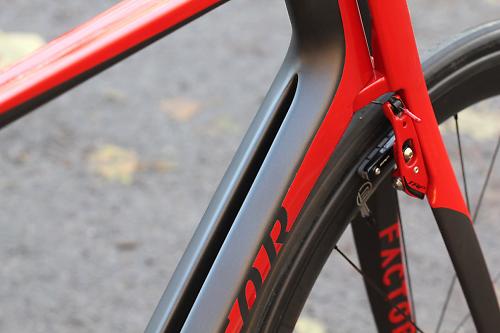
It has proved in the wind tunnel to be an extremely efficient setup, and from a torsional stiffness standpoint it makes a lot of sense. We’re not just doing something different for the sake of being different. There’s a functional reason for every single one of the decisions made on this bike.
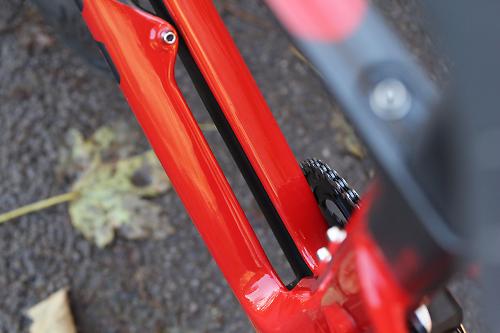
Through computational fluid dynamics (CFD) and wind tunnel testing we were able to check the split versus non-split down tube and we found that splitting the down tube offers 100g of aerodynamic efficiency on our bike. That amounts to about one second per kilometre.
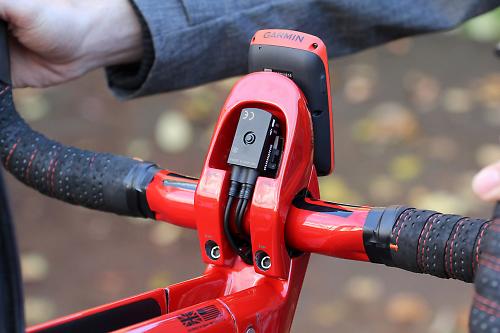
When you compare our bike as a whole against other aero road bikes, it’s among the more aero but it’s not as aero as the best. A lot of the more aero bikes tend to be less efficient from a torsional stiffness standpoint and you have to balance both those things. The Cervélo S5 was the most aero bike we tested, but it was not as torsionally stiff as our bike so its power transfer is not as efficient. Our bike is as stiff in the bottom bracket area as the Scott Foil and the Cervélo R5, but much better in terms of aerodynamics.
The original 001 had a split seat tube too. The problem with that from a structural standpoint is that the tubes are really thin and it puts the chainline out really far, and the subsequent Q-factor [the horizontal distance between the pedal attachment points] was a bit wide on that bike.
At the front end you have a dual-crown fork with an integrated stem. What’s the thinking behind that?
It’s remarkable how much flex happens in a standard system where you have an axial load of a handlebar, attached to an axial load of a stem, attached to an axial load of a steerer tube, attached to an axial load of a wheel. Within that system you’re creating points of twist with all those axes.

When you ride a system like this you realise you have a direct connection from what you do with the handlebars – whether that’s steering or leaning – to what happens to the bike. We’ve increased the direct connection between the handlebars and the dropout and also increased the direct connection between the front end and the entire frame.

The head tube is loaded on the top and the bottom like a downhill mountain bike, and that changes the entire dynamics of how the bike handles, steers, changes direction, or even sprints.
Plus, from an aesthetic point of view, I didn’t want to look down at a cockpit that has bolts everywhere!
You presumably have different stem options?
We have three different length stems, and we also have a wedge system that gives you seven different handlebar positions for each. The handlebar can go right in the centre, or you can use wedges that put it high or low, forward or backward, or in between – there’s 10mm of adjustment for each.

At the moment, we’re a direct-to-consumer company so we’re encouraging people to send us their fit data and we’ll set up the bike.
And what about seatpost adjustment?
You can choose from zero to 30mm offset plus, obviously, whatever’s available on the saddle rails.
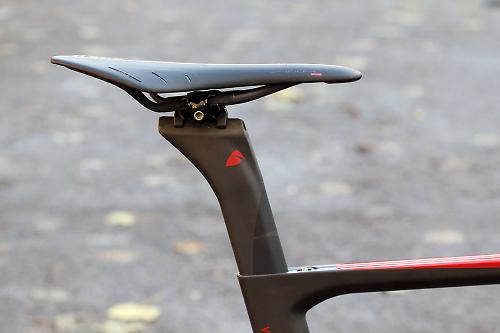
What can you tell us about the power-measuring crank system?
It’s by far the most technologically advanced power meter that exists today. We’re doing stuff with the power meter that other people won’t be able to do for another two or three product generations.

The cranks are built to F1 specs. We use strain gauges out of F1 cars and they’re incredibly accurate. Once calibrated, you never need to recalibrate them. Temperature is not an issue.
What information do they provide that’s so special?
These cranks are so powerful in terms of the pedal stroke data that they can show you. They communicate with the Garmin 810 via ANT+. ANT+ can only handle 4Hz of data, and the 810 only picks up data once a second, so we are currently working on our own data logger to replace the Garmin.
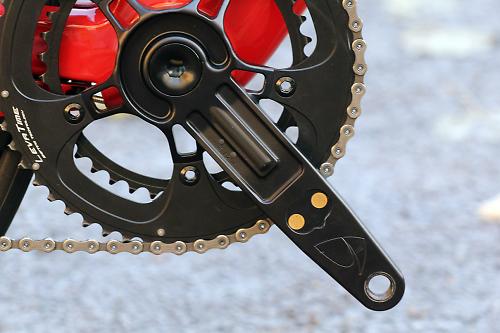
If you pair the cranks to the data logger, they’ll transmit in ANT mode rather than ANT+ mode, and then we can determine what the data rate is. They’ll communicate at 192Hz, so you can imagine the resolution change you get there.
That means we can monitor every degree of rotation in the cranks and tell you where you’re putting pressure down, where you’re putting negative pressure – where your pedal stroke is suffering and you’re not getting optimal power.
When you look at our pedal torque circles, we can tell you not only whether your pedal stroke is unbalanced but why it’s unbalanced. With the Factor logger you can see it on the front of your bike and also Bluetooth it to a computer in real time. You can put the bike on a turbo and have live data on your pedal stroke as you ride – similar to a Wattbike. You can see the effect of moving your saddle forward 2mm, or moving it down 5mm.
The bike comes fully built up, right?
Yes, and it comes with the Factor Power cranks and the Garmin 810 computer that has been custom-made for us – it’s a colour matched and Factor branded head unit. It comes with a heart rate monitor strap and a built-in speed sensor.
The seatpost is obviously proprietary. What about the rest of the components?
The TRP brakes are standard TTVs but we customized the linkage pieces and got rid of the external noodle to be able to route internal cabling – all the cables are internally throughout the entire structure.
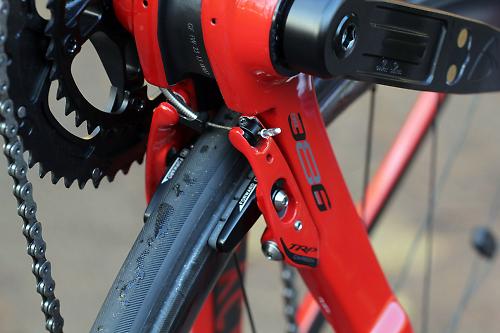
The full internal cabling is not an easy thing to do. We use full housings so there’s really nowhere for contamination to get in, even in British conditions – so we don’t anticipate a big issue with it.
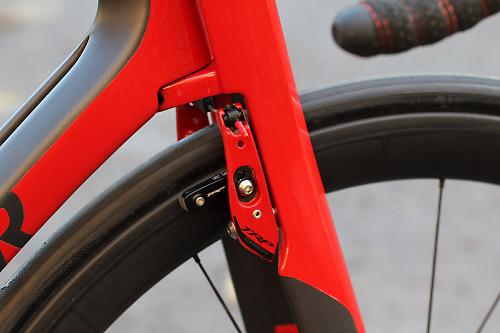
And the wheels?
They’re co-branded, developed by a company called Black Inc. It’s a fat profile aero rim with a blunt edge instead of a sharp edge. They work aerodynamically with the frame really well.

Who’s your target consumer?
It’s the discerning road rider who wants something that’s amazing. A lot of people who have ridden the bike so far have been blown away by the way that it rides. We didn’t just do this configuration because it looks cool and striking. Ride quality was paramount.

The geometry is very racy but not as slammed as a full race bike. We want people to race this bike but for most people who will buy this bike, racing is not a full-time thing. They’re bike enthusiasts and it’s something they do passionately, and they’re passionate about having the best gear.
Standby for a review of the Factor Vis Vires on road.cc soon. For more info go to www.factorbikes.com.
Mat has been in cycling media since 1996, on titles including BikeRadar, Total Bike, Total Mountain Bike, What Mountain Bike and Mountain Biking UK, and he has been editor of 220 Triathlon and Cycling Plus. Mat has been road.cc technical editor for over a decade, testing bikes, fettling the latest kit, and trying out the most up-to-the-minute clothing. He has won his category in Ironman UK 70.3 and finished on the podium in both marathons he has run. Mat is a Cambridge graduate who did a post-grad in magazine journalism, and he is a winner of the Cycling Media Award for Specialist Online Writer. Now over 50, he's riding road and gravel bikes most days for fun and fitness rather than training for competitions.
Latest Comments
- Rendel Harris 1 sec ago
It's a standard practice in all UK media as well, can't say I'd miss it if they didn't but equally I'm not going to shed any tears about bastards...
- ktache 12 sec ago
Was thinking about getting a Rohloff one, but then I got a Rohloff which made it a bit pointless. And, of course I only found about it when I was...
- edward.s 19 min 18 sec ago
I love how you talk about quality Hex wrenches and then show a picture of some Draper ones! Wera or Bondhus far better.
- pockstone 1 hour 17 min ago
If one's knuckles are several inches below one's ankles...?
- ribena 1 hour 36 min ago
This is awful but I'm pretty sure they were riding surrons (electric motorbikes) not bicycles.
- giff77 2 hours 41 min ago
Longwater junction is just nasty at the best of times. Road markings have vanished and it's a total free for all no mater what direction you are...
- JoanneH 2 hours 55 min ago
I can do the basics, but largely I prefer to take my bike to the LBS when it needs a service, when they check all the big things and sort them out...
- chrisonabike 3 hours 9 min ago
Agree about the blue badge / double yellows ... as you say it's moot in practice....
- eburtthebike 5 hours 10 min ago
Twas ever thus.













































Add new comment
20 comments
Seems impressive but at the same time not really ground breaking especially for the lack of customization and that price tag!!!
Ground breaking... was it supposed to be ? Admittedly the power meter, allbeit with proper L/R data, is not unique - though perhaps quite good but i'm unsure about how many other bikes i've heard of with a split fork and down-tube... or did it need more ?
Also of course it's bloody expensive but, given the manufacturer and their pedigree, did you really expect them to flood Halfords in half a dozen sizes with a Cycle To Work price-tag - or recognize what they're producing might be a tad niche at the moment. They've already said you can send in your fit and they'll try and come up with something... come on - you are sounding a bit mealy-mouthed.
Does anyone know what brand of bar tape that is? (yeah I know...)
Looks like busyman bicycles black with red stitching, though Planet X also make black leather tape with red stitching that looks like that
"If you pair the cranks to the data logger, they’ll transmit in ANT mode rather than ANT+ mode, and then we can determine what the data rate is. They’ll communicate at 192Hz, so you can imagine the resolution change you get there.
That means we can monitor every degree of rotation in the cranks..."
I may be being pedantic and I may have my maths wrong, but if I pedal at 90rpm, that is 540 degrees of rotation per second, so 192Hz would only give about 2.8 degrees resolution.
Of course, you could just ride it and enjoy the scenery...
That stem/headtube thing is exceedingly ugly.
Disappointly heavy for a 10k bike. Mind you, people still buy Dogma's so i guess weight isn't everything...
Have to agree, you're into 5kg Cervelo RCA territory at this price. Love the look of the bike, but those cranks are seriously ugly.
cripes that head tube assembly is hard on the eyes ... as said, the detail leaves a lot to be desired. I doubt if the designer has been a bike designer that long ..
To be honest, when you look at the detail its pretty poor really. Those bottle cage mounts are massive blobs, the bottom of the stem is not particularly well done and the moulding of the aero form around the brakes has such big gaps it probably causes more drag than advantage.
Yes i know i couldnt do better, but i can certainally see better on every top end model from every other brand in my LBS. And they are not $10k!
That's not quite true - it's set by a 16-bit integer (32768) divided by the message period. It does default to 4Hz but the message (channel) period is normally set to a particular value in the relevant device profile (e.g. Power, Cadence, HRM and so on) to try and ensure maximum compatibility between devices.
If you're doing your own logger however, you can do what you like and in that case it's kind-of irrelevant whether you use ANT or ANT+ for talking to the logger - you could use either and sample at 1KHz say - then that could even then re-issue any data inline with the appropriate profile to a bog standard head-unit if desired for some reason.
I do hear some strange reasons for not using ANT or ANT+, for example Kurt saying they needed bi-directional comms on the InRide so had to use BTLE instead of it (which is rubbish) - sampling rate is not a real one unless you have to talk to other things which are following a particular profile to the letter, like the Garmin at 1Hz data read.
You don't even need a particularly high data rate if you're doing your own thing, as you have control of the packet structure you can pack multiple data points into a single packet and use a lower frequency. Loads of things are possible....
What use is a £10,000 superbike if you're locked into a position on par with an 80 year old woman's Dutch bike?
Was just thinking that. Sunday-ride-stem-angling-fail.
I'm guessing you missed this section...
..or this bit ?
..or just bowing down before rule #45 ?
I for one would love to see a video of an 80-year-old Dutch woman riding this bike. Come on road.cc, we know you have a video camera lying around somewhere?
Maybe its the photos (or post ride sludge) but that looks like a ropey paint job.
Yes please, I'll take 2 if I can get mudguards on for the winter version
Wow! And it's in my size too...
Other testers are also available...
I like all the integration, internal routing, clean lines etc but there's one thing that's buggin' me - the cable end sticking out on the front brake!